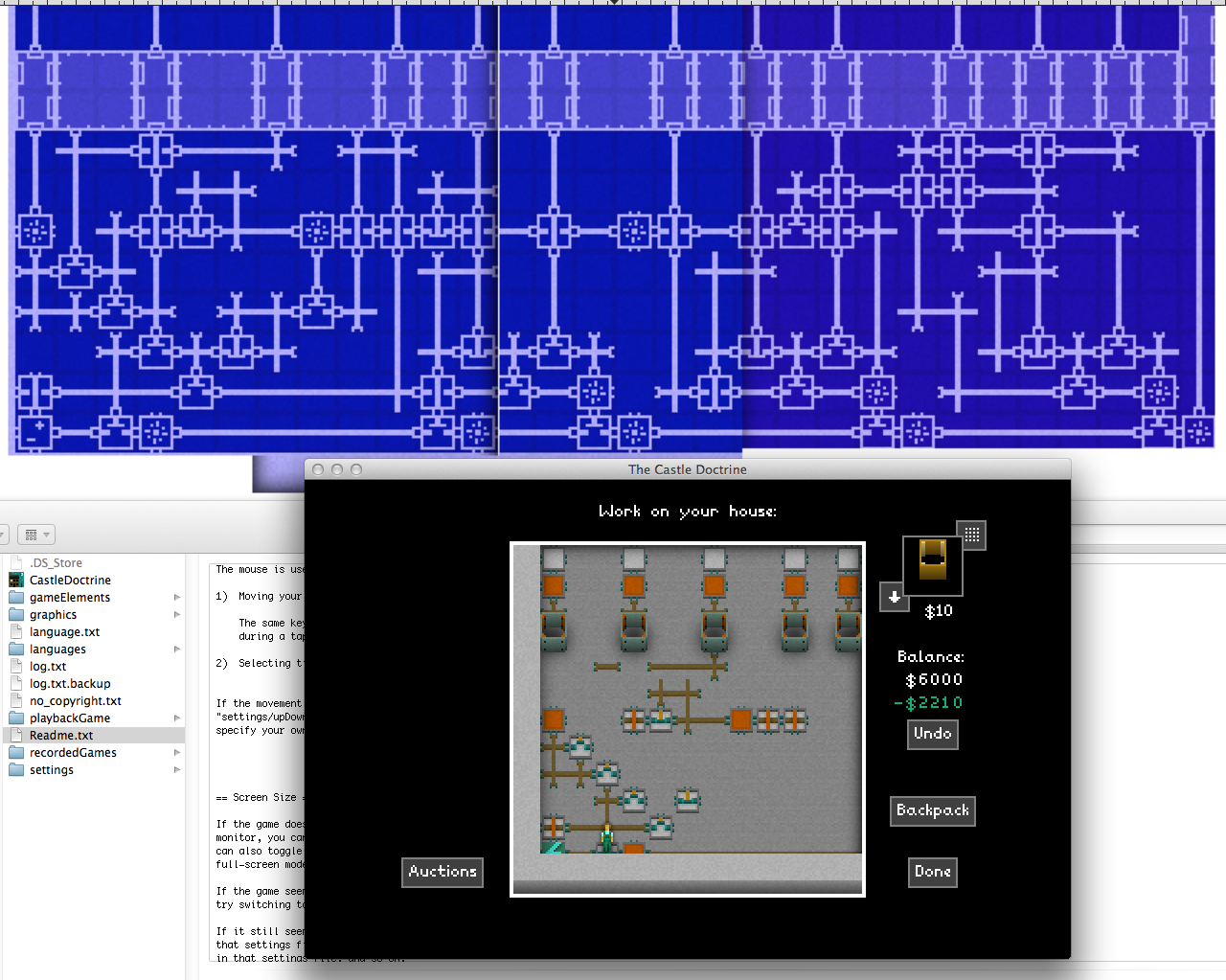Sneaking into Rohrer's Castle - Part 3
Check out Part 2. In this post, I discuss how the game is evolving.
HatchetCraft
On April 8, PC Gamer released their review of The Castle Doctrine. The game had been in public alpha for less than one month. The review was just over 600 words. It ended with the number 50, citing lack of tutorial and a "willfully obtuse design."
I was livid. Low review scores can have a dramatic impact on sales. A large company can offset low scores with huge marketing budgets, but a solo developer living on the equivalent of minimum wage? Forget it. Minecraft popularized the paid alpha and yet PC Gamer didn't write that review until the full release, over two years after Notch had started charging money. Besides, dooming an alpha game to failure because it lacks a tutorial is ludicrous. Two words: Mine. Craft. To top it all off, they didn't even get the price right.
PC Gamer changed course two days later. They apologized, took down the score, and claimed that they were creating a policy for reviewing preleases in order to "evolve along with" changing funding methods. I think they made the right call in the end, but what if they hadn't?
Imagine for a moment that in July 2009 a well known gaming magazine decided to review Minecraft; this would have been one month after its paid alpha began. At the time, there were no skeletons, zombies, or creepers. There was no redstone. No farming. No minecarts. Crafting wouldn't arrive for another 6 months. That's right: Minecraft had no crafting. This is what the game looked like:

Imagine if some rogue game critic wasn't impressed and decided to settle the matter, in July 2009, with a bad review. Personally, I'd be hesitant to buy a game with no demo and an abysmal score. If that review had happened, it's possible that Notch would still be working at Jalbum. Mojang would be a middling side project. The gaming world would be much, much different. I'd have gotten a lot more sleep. The thought is terrifying!
The PC Gamer score might not seem like a big deal, since it was only up for a few days. The issue is complicated, however, by Metacritic; it has a long standing policy to refuse to update scores, even when the information in the original review is widely known to be false. The only criteria for a game getting on Metacritic is that multiple publications have reviewed it. I wondered if Metacritic might have a policy against accepting alpha or beta reviews, so I posed the question to cofounder Marc Doyle. He responded cryptically, "Our critics have reviewed alpha and beta versions of games, but we want them to focus on the completed game." Translation: it's up to the reviewers to not screw things up. The Castle Doctrine was one more review away from a permanent 50.
In a world of Kickstarters, Early Access, and all manner of homebrew crowdfunding we need to think carefully about how we approach works in progress. After all, we're not just talking about crushing fledgling creative projects, but also people's livelihoods.
Ladders all the way down
One of the reasons why The Castle Doctrine isn't ready for a final review is that it's still being battle tested and balanced. Having said that, I don't expect many major features to be added. After playing 13 versions, I've only seen a single new tool. Rather, small tweaks are propelling the game forward in dramatic ways. The overriding theme of most changes has been to make home owners more vulnerable:
- ladders to get across pits, which previously had no counter
- free blueprints for all houses
- infinite backpacks, as opposed to only carrying up to 8 items

It's not all bad for home owners. Many changes have been added, for instance, to make pitbulls more effective (pitbulls happen to be the only real way to protect your family):
- tool use went from taking 1 turn to 0 turns
- pitbulls became immortal (but asleep) after consuming drugged meat
- living pitbulls started avoiding the tiles next to dead pitbulls
From the outside looking in, those changes might seem nitpicky or even nonsensical. Having played through those changes though, I can vouch for how desperately each was needed to combat player behavior and how impossible it would have been to foresee the need for those changes before testing. Take the 1 turn tool use for example. Pitbulls can be killed cheaply with a $100 crowbar, but the crowbar doesn't have the range of the $1,000 gun. If you're two spaces away from a pitbull, the crowbar is useless. What players would do is cut through a wall with a $100 saw, which kept them in position but let the dog move. In hindsight it makes sense, but I never would have predicted it. In software development, this is sometimes called a "wicked problem." You don't actually know what you have to build until you build it and find out if you were right.
Great artists steal
One of the most interesting bygone features was blueprints. Though they were removed, I'm still holding out hope that they might get added back in in some form or another. They were added because houses in version 5 were quickly becoming impossible to beat. The canonical example was a "combo lock," a series of switches that required a specific combination of ON and OFF (basically, a binary password). Blueprints were eventually removed because they had turned the game into a puzzle/wiring game. Rohrer explains in detail here.

After blueprints had ruined mazes and the like, the only thing left was diabolically hard puzzles. Some depended on the the idiosyncrasies of the pet behavior (i.e. some people were reading the source code to gain an edge). Others consisted of circuits so complex and obfuscated that they eluded hundreds of robbers for days, even though blueprints were freely available and they effectively served as detailed wiring diagrams.
You can obviously see why blueprints were later removed. For an electrical engineering nerd like myself, however, that puzzle aspect was delightful.
The blueprints strongly evoked scenes from your average heist film. The first thing the thieves always do in a heist film, of course, is build a life sized recreation of the vault (usually to practice slithering around laser beams). So that's exactly what I did. One Mr. Hayes had invented a complex wiring scheme, one that depended on a recently discovered sequential logic implementation. Long story short, the circuit didn't just depend on the current buttons being pressed, but also on the sequences of buttons previously pressed. I put in substantial effort, but couldn't decipher the entire circuit on paper. Instead, I stitched together several screenshots of the blueprint and recreated almost half of Mr. Hayes's setup in my own house. Then I began to test different components and how different button presses interacted. All the while, the clock was ticking; if anyone else beat me to the punch while I screwed around, I'd be left empty-handed. Finally, a breakthrough. Then another. All told, I spent several hours plotting the robbery against Mr. Hayes, but I was able to walk with over $50,000, an exorbitant amount of cash.
I can't stress enough how satisfying robberies are. In almost all other games, your victories mean only that you've overcome challenges designed to be beaten. Your victories in this game mean that you've beaten something not meant to be beaten at all.
Hard to be a man when there's a gun in your hand
You should play this game. Not because it's loads of fun, though it is. I think you should play The Castle Doctrine for two reasons.
First, because we gamers are spoiled. I'm not just talking about games being easy. I'm talking about games being so forgiving that your actions are ultimately meaningless. I already linked to a scene from Call of Duty where the player wins a level without shooting his gun. In a similar account, Mark Serrels discovers that not pressing buttons in Ryse has no visible effect on quick time events. You lose a great deal of tension when your controller is turned into a panel of placebo buttons. The Castle Doctrine is so intense, however, that a "safe movement" mode was added recently because players were dying frequently from shaking hands.
The second reason is that The Castle Doctrine tries, and often succeeds, at making one feel emotions that are rarely encountered in video games: vulnerability, impotence, worry, remorse. Violence and crime have always been important themes in storytelling and art. Blood is compulsory, dontcha know? But when games deal with violence, they do it in such a clichéd and childish manner. More often that not, violent games can be summed up as Adolescent Male Power Fantasies. Beat the baddies. Get the girl. Be the hero. Hell, MMOs are assembly lines for making players into heroes.

Not here. What Rohrer has done is craft a violation engine. A system that asks if would like to take away something real (time, effort, and hope) from a real person and then hands you the crowbar. Sure, there's fanciful elements sprinkled about, but it's not an adolescent power fantasy. It's the reverse: a Mundane Adult Nightmare.
You don't get the girl; you lose your family. You're certainly not the hero. The only choice you really have is whether to play the villain. In fact, most of the time you're nobody at all. You're just another name on a list until someone else decides — and trust me, they will, over and over — to make you the victim.
The Castle Doctrine is currently in public alpha. Check it out here.
If you need tips to get started, I wrote a short guide.
Vote on HNDiscuss on Hacker News, you know, if that's like your thing.
Hitherto
Sneaking into Rohrer's Castle - Part 2Sneaking into Rohrer's Castle - Part 1
Permalinks
Short: http://jere.in/3Pretty: http://jere.in/sneaking-into-rohrers-castle-part-3

